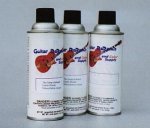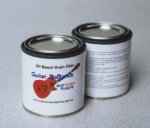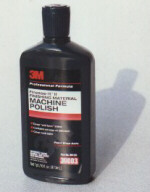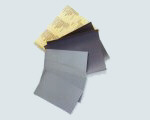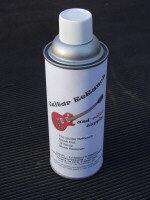 | Fender Neck Amber
Neck
Amber replicates the amber look used on Fender necks as well as many other solid body electric necks. It is shown here on maple.
The color can be adjusted from the darker look of the fifties and sixties
to the lighter look of the seventies by varying the number of passes sprayed.
The aerosol contains the correct aniline dye color mix but contains no
lacquer in the mix. Therefore, it must be clear coated after the color
has been applied. |
|
 | Fender
Blonde
The
color is slightly whitish and was mixed to the color
found in the neck pocket of a '62 Telecaster. The color originally appeared
in 1956. It is a pigmented color that opaques the grain if sprayed too
heavily. The grain should be opaqued about 50%. Clear coat with nitrocellulose
for a finish that will age over time. |
|
 |
Butterscotch
Butterscotch
is an aniline dye blend which does not opaque
the grain. It has been matched to the body of a '52 Telecaster Reissue
(1983). The color also works well on birdseye maple capped Tele's as it
enhances the birdseye. It can be used for tinting maple necks as
well. Shown here on ash. |
|
 |
Butterscotch
Blonde
Although
the original color as applied in 1952 may
or may not have not been the color we know today, nearly 50 years of aging
(and a lot of cigarette smoke) has given us the color most associated with
the Tele's of the early fifties. The color is pigmented and should be applied
lightly so as not to completely obscure the grain. This is the color you
need for your new "Relic" |
|
 |
Black
In
the past I have used and recommended a well known manufacturers nitrocellulose black for the pigment coats of
Black Beauties and such. I have been told that the color in nitrocellulose
is difficult to find. So, if you need a very opaque nitrocellulose
that when clear coated shows great depth and gloss this is the color for
you. |
|
 |
Copper Tone Metallic
In
1954 Fender produced a prototype Tele in copper. Fender has since offered the color on special order '52 Reissuses. Copper
Tone Metallic replicates that color. The color is blended in a high metallic
acrylic lacquer and depending on the light source along with the
viewing direction will appear to be light gold to copper to red copper.
It should be applied over a prepped and white primed body. The color can
be used with or without a clear coat. However, clearcoating with nitrocellulose
slightly deepens the color and makes the color appear more "coppery". |
|
 |
Daphne Blue
Daphne
Blue found its way into the Fender color
scheme in 1960 and stayed until 1965. Originally an automotive color, it
was offered only on the 1958 Cadillac. Like many of the colors from the
Custom Color era it is again offered by Fender. Slightly darker than Sonic
Blue, Daphne Blue can be warmed and aged with a clear coating of nitrocellulose
lacquer. A white primer is recommended for more efficient covering. |
|

 |
Cherry and Heritage Red
Both
the Cherry (Es335 Red)
and Heritage Red (SG Red)
can be replicated with the same aerosol spray. The choice of wood will
determines the final color. This first sample shows the aerosol color sprayed
over maple which was first tinted with a water based aniline dye (in this
case our GRREDL) . The second sample shows the Cherry Red aerosol as it
appears when sprayed over untinted mahogany. Both applications
require clear coating to bring out the vibrant nature of the color.
|
|
 |
Dakota
Red
Introduced
in 1958 for Cadillac the color was quickly ushered
into the Fender line of colors. It can be sprayed over the prepped and
filled body or over a prepped and filled body sprayed with a white primer.
The color completely opaques the grain and is the "reddest" of the Fender
colors. If clear coated a "deeper" finish can be obtained.
|
|
 |
Fiesta
Red
Although
Fender seemed to favor General Motors colors for their guitars here is a color for the Ford guys. Fiesta Red found its way to
the public eye on the '56 Thunderbird and was discontinued the next year.
It was used by Fender from '60 to '69. The color is lighter and more orange
than the truer red of Dakota Red. Fiesta Red will look great with white
trim. Can be clear coated for a deeper finish. |
|
 |
Gold
Top Gold
Original
Gold Top powder as first used by Gibson in 1952 for the Les Paul model is actually a fine bronze powder. Bronze powder, as opposed
to a mica powder, will show a slight green iridescence as do original Les
Pauls they are when viewed at an angle. The supplier of our powder is also
the bronze powder supplier to Gibson. All of the Gold Tops (including the
'54 shown to the right) refinished by The Reranch in the last year have
been "gilded" using the aerosol sprays. Not only do the aerosols spray
the powder more finely and evenly than most spray rigs, the tedious task
of cleaning the powder from the spray gun is eliminated. One can should
be enough for a top. Spray the powder over a white primer for quicker coverage
and after applying the gold must be clear coated to protect it and "lock"
it in place. Body preparation is very important so be sure to review the
steps given on the ReRanch Gold Top page. |
|
 |
Inca Sliver
The
color first appeared on the 1957 Corvette and continued through
1959. Fender used the color from 1960 until 1965. The color has a
high metallic content but due to the fineness of the metallics it is very
easy to apply. Unlike some metallics If too wet of a coat is applied Inca
Silver dries flat and consistent. The color can be used with or without
a clear coat and a white primer is preferred. |
|
 |
Lake
Placid Blue Metallic
One
of the all time favorites among "Fenderphiles", it is aptly suited for the Strat type guitars in that the color changes from a medium
blue metallic to a dark navy solid depending on ones viewing angle. The
gentle flow of the body contours of the Strat take great advantage of this
quality. It is a one layer color and can be applied over a prepped body
or a prepped and white primed body. Clear coating adds to depth and iridescence
and protects the metallic particles from any possible oxidation. And perhaps
contrary to your intuition, Lake Placid Blue Metallic is a very easy finish
to apply. |
|
 |
Olympic
White
While
very white the color has a slight blue component in the mix.
It can be clear coated to give an aged yellow appearance although it is
believed that Fender did not clear coat the color because of this very
reason. A white primer coat will serve well to prevent any natural color
in the wood from bleeding through. It is a great color for use with gold
components such as seen on the SG Les Paul Custom. |
|
 |
Sea
Foam Green
Slightly
darker than Surf Green, Sea Foam Green (also
called Foam Green by Dupont) is a great choice for either a Strat or Tele
style body. Originally seen on the '56 Buick it saw life with Fender from
'60 to '69. The color should be clear coated for a deeper shine. |
|
 |
Sherwood
Green
Originally
seen on the '57 Mercury it was used by Fender from
1960 to '65. The color is a medium green with silver metallic undertones.
While dark enough to apply directly over prepped wood a white primer coat
is recommended. With a primer coat one can should be enough for a body
and peghead. |
|
 |
Shoreline
Gold Metallic
A
lighter gold than GoldTop Gold and more forgiving in it's application.
The color is similar to the modern color "champagne". It was first seen
on the '59 Pontiac and used from '60 to '65 by Fender. Although, there
was a '58 Fender Shoreline Gold color in '58 it is believed that the color
was a one off custom color and not true Shoreline Gold. The color works
best over a white primer and clear coated. |
|
 |
Sonic
Blue
What
a color! It will work on any style solidbody but is especially revelent to the Mustang. Why Fender liked the color so much for the Mustang
is a question left to be answered. However, the dirth of Strats and P-Basses
finished in the color make them much more desirable. A very easy color
to apply and when clear coated will age with grace. |
|
 |
Surf Green
The
color, if not a brother, is a close cousin of Sonic Blue. Most of
you older guys will remember it from the '56 Chevy. The younger guys will
remember it from... well, their Dads' '56 Chevy. As evidenced by
the prices (that is, if you can find one), there are not a lot of Surf
Green any things out there. If you want an easy to apply color you will
not see again in a "Blue Green Moon" this is the one for you. Clear coating
will again only add to the beauty. |
|
 |
TV
Yellow
TV
Yellow was developed by Gibson in the early '50s to allow a "white" guitar to be played under the intense light required for black
and white TV without the color overpowering the camera. The color is opaque
but still shows the grain. It will display this magic only on an open grained
wood. The subtle display of grain is difficult to display and may not show
in the sample. I think it has overpowered my scanner! The color works
best on mahogany. See the TV Yellow page for more information. |
|
 |
Vintage Cream
Seen
on Strats and Teles from the late '60s until about 1974 it has
since been reoffered as "Vintage White" by Fender. The color is a light
yellow that is probably best described as "banana pudding". The color is
opaque and should be applied over a white primer and clear coated for the
best gloss. The color will work with either a white or black pick guard.
Vintage Cream should be one of the easiest colors to apply. |
